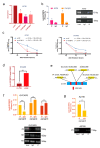FTO Inhibits Epithelial Ovarian Cancer Progression by Destabilising SNAI1 mRNA through IGF2BP2
- PMID: 36358640
- PMCID: PMC9658695
- DOI: 10.3390/cancers14215218
FTO Inhibits Epithelial Ovarian Cancer Progression by Destabilising SNAI1 mRNA through IGF2BP2
Abstract
Fat mass and obesity-associated protein (FTO) regulates critical pathways in various diseases, including malignant tumours. However, the functional link between FTO and its target genes in epithelial ovarian cancer (EOC) development remains to be elucidated. In this study, the biological functions of FTO were verified in vitro and in vivo. The m6A modification and the binding sites of SNAI1 mRNA were confirmed by m6A RNA immunoprecipitation (MeRIP) and RIP experiments. The actinomycin D assay was used to test the stability of RNA. We found that FTO was downregulated with increased m6A levels in EOC. Reduced expression of FTO was associated with a higher FIGO stage in patients with EOC. Mechanistically, FTO decreased the m6A level and stability of SNAI1 mRNA, causing downregulation of SNAI1 and inhibiting epithelial-mesenchymal transition (EMT). Furthermore, FTO-mediated downregulation of SNAI1 expression depended on IGF2BP2, which acted as an m6A reader binding to the 3' UTR region of SNAI1 mRNA to promote its stability. In conclusion, FTO inhibits SNAI1 expression to attenuate the growth and metastasis of EOC cells in an m6A-IGF2BP2-dependent manner. Our findings suggest that the FTO-IGF2BP2-SNAI1 axis is a potential therapeutic target in EOC.
Keywords: EMT; FTO; IGF2BP2; SNAI1; m6A; metastasis; ovarian cancer.
Conflict of interest statement
The authors declare no conflict of interest.
Figures









Similar articles
-
GAS5 regulated by FTO-mediated m6A modification suppresses cell proliferation via the IGF2BP2/QKI axis in breast cancer.Discov Oncol. 2024 May 23;15(1):182. doi: 10.1007/s12672-024-01051-8. Discov Oncol. 2024. PMID: 38782769 Free PMC article.
-
FTO/IGF2BP2-mediated N6 methyladenosine modification in invasion and metastasis of thyroid carcinoma via CDH12.Cell Death Dis. 2024 Oct 8;15(10):733. doi: 10.1038/s41419-024-07097-4. Cell Death Dis. 2024. PMID: 39379360 Free PMC article.
-
RNA N6-methyladenosine reader IGF2BP2 promotes lymphatic metastasis and epithelial-mesenchymal transition of head and neck squamous carcinoma cells via stabilizing slug mRNA in an m6A-dependent manner.J Exp Clin Cancer Res. 2022 Jan 3;41(1):6. doi: 10.1186/s13046-021-02212-1. J Exp Clin Cancer Res. 2022. PMID: 34980207 Free PMC article.
-
FTO m6A Demethylase in Obesity and Cancer: Implications and Underlying Molecular Mechanisms.Int J Mol Sci. 2022 Mar 30;23(7):3800. doi: 10.3390/ijms23073800. Int J Mol Sci. 2022. PMID: 35409166 Free PMC article. Review.
-
The role of IGF2BP2, an m6A reader gene, in human metabolic diseases and cancers.Cancer Cell Int. 2021 Feb 10;21(1):99. doi: 10.1186/s12935-021-01799-x. Cancer Cell Int. 2021. PMID: 33568150 Free PMC article. Review.
Cited by
-
Stabilization of SQLE mRNA by WTAP/FTO/IGF2BP3-dependent manner in HGSOC: implications for metabolism, stemness, and progression.Cell Death Dis. 2024 Dec 1;15(12):872. doi: 10.1038/s41419-024-07257-6. Cell Death Dis. 2024. PMID: 39617776 Free PMC article.
-
IGF2BP2 Shapes the Tumor Microenvironment by Regulating Monocyte and Macrophage Recruitment in Bladder Cancer.Cancer Med. 2024 Dec;13(24):e70506. doi: 10.1002/cam4.70506. Cancer Med. 2024. PMID: 39711402 Free PMC article.
-
RNA N6-methyladenosine modification in female reproductive biology and pathophysiology.Cell Commun Signal. 2023 Mar 9;21(1):53. doi: 10.1186/s12964-023-01078-4. Cell Commun Signal. 2023. PMID: 36894952 Free PMC article. Review.
-
Medicinal chemistry aspects of fat mass and obesity associated protein: structure, function and inhibitors.Future Med Chem. 2024 Aug 17;16(16):1705-1726. doi: 10.1080/17568919.2024.2380245. Epub 2024 Aug 5. Future Med Chem. 2024. PMID: 39101588 Free PMC article. Review.
-
TMAO Promotes NLRP3 Inflammasome Activation of Microglia Aggravating Neurological Injury in Ischemic Stroke Through FTO/IGF2BP2.J Inflamm Res. 2023 Aug 28;16:3699-3714. doi: 10.2147/JIR.S399480. eCollection 2023. J Inflamm Res. 2023. PMID: 37663757 Free PMC article.
References
Grants and funding
LinkOut - more resources
Full Text Sources
Research Materials
Miscellaneous

